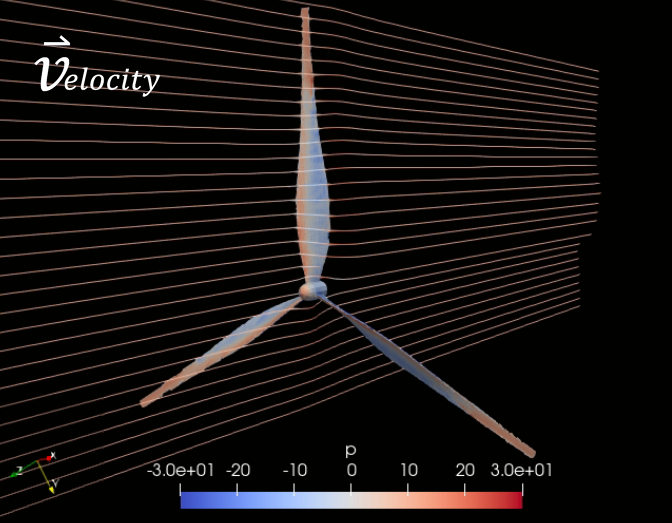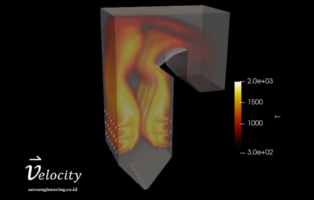computational fluid dynamics (CFD) industrial application
The development of computation technology and high demand of fluid dynamics research and problems make the Computational Fluid Dynamics (CFD) technology mature and feasible to be used not only in theoretical application, but also in the real industrial and business applications. (to learn more about CFD, click here).
From the historical point-of-view, CFD was born in the aerospace application in the 1970s (we must remember during that period, computer costs were very high compared to nowadays, almost everybody in the modern community could afford the computer). Quoted from MIT press at 1989:
“In the end of 1970s, using supercomputer to solve aerodynamics equation began to paid off. Early success shown by the experiment conducted by NASA from their HiMAT (high manoeuvrable aircraft technology) project, which designed and tested for the next generation jet fighter. Initial test was conducted by wind tunnel to do the preliminary design. The design was predicted had excessive drag force in near speed of sound, and if the physical prototype constructed, the data will be useless. The redesign cost for that wind tunnel almost $150.000 and would pending that project. Instead of using wind tunnel, the project was redesigned using supercomputer (CFD) with cost only $6.000.”
It was a huge cost reduction, moreover, the computer (hardware) and the computational technology during that time was much more costly compared to the present technology. That was the background and initialization of CFD utilization to replace (or at least complete) the physical prototyping. (to learn more about digital prototyping vs physical prototyping click here).
At the present time, CFD is a feasible and powerful tool to be used in several industrial (engineering or non-engineering) applications. Here are some typical CFD applications:
- Aerospace Industry
Aerospace application maybe the most obvious and most intensive in therms of CFD utilisation. Using CFD, we can easily predict the lift, drag and moment of different aircraft wing, tail, fuselage and many-more custom configurations. Moreover, we can predict the fluid flow pattern and easily alter the aerodynamic design to optimise the performance.

The above example is just the most obvious and common problem, in aerospace application, we can also predict the engine intake performance, propeller interaction, control-surface efficiency or maybe reconstruct the particle trajectory and hit the vehicle to predict the space shuttle launch failure such as done by NASA.

2. Maritime
One of very old discipline in fluid mechanic is maritime technology. Although very old and used to design from ships, submarine to offshore buildings, maritime technology is still relatively complicated due to its nature of air and water interaction (multiphase) creating a wave. By using computational fluid dynamics (CFD) technology, we can easily predict the free surface wave interaction with the hull or other objects, hence enable us to predict the hull drag whether caused by skin friction as well as by wave interaction.
Another example is the design of a propeller. As the propeller blades rotating, high velocity on its surface will be followed by low pressure (Bernoulli’s principle), and at a certain condition, this low-pressure region will cause the water to evaporates, or known as cavitation. This cavitation bubbles will adversely affect the propeller performance, from reducing thrust to increasing noise which is very crucial in the submarine propeller design.
3. Automotive
The automotive industry is a very competitive industry, high performance while low production cost product design is a must for mass-produced parts. Using CFD simulation, automotive manufactures are able to predict and optimize some parts such as piston and engine combustion, muffler noise, fuel manifold, oil lubrication, or turbocharger effectiveness.
Not only for the internal part, but the simulation of car (typically racing car) aerodynamics to determine its drag and downforce are also common in the automotive design competition. Lower the drag force indicates better aerodynamics efficiency hence reduce the fuel consumption and improve the maximum speed (with the same engine).

4. Process
Not only deals with flow velocity and pressure, but CFD also can solve chemical reaction (species), combustion, drying, and many more physical modeling. High investment cost in the process industry makes proper design before these facilities are construction is a mandatory, and one of the common tools to conduct this proper design is CFD simulation.

5. Building and Construction
Trend of green building design and power reduction (Especially from air conditioner) drives the proper ventilation and natural convection design, and the most feasible and powerful tool to be used in these analysis is CFD. Not only for comfort, CFD also used to analyse the distribution of toxic gas inside the building, for example is CO concentration emitted by cars inside an indoor parking lot which is very crucial in the safety design of the building, or the fire spreading in case of building fire.

6. Energy
One of industry with intensive usage of fluid dynamics analysis is energy sector. From coal or gas power plant, we deal with pumps, blower, fans, pipings and many other fluid devices. CFD is a common tool to analysis these devices, from initial design to address the root cause of a problem such as overheating, erosion etc.

In the renewable energy sector, wind turbine development keeps growing fast. This fast development, especially on the blade aerodynamics performance, is driven by CFD analysis because its complex 3D rotating flow are hard to solve using analytical method.

To read other articles, click here.

aeroengineering.co.id is an online platform that provides engineering consulting with various solutions, from CAD drafting, animation, CFD, or FEA simulation which is the primary brand of CV. Markom.
References
[1] Columbia Accident Investigation Board, Report Volume 1, August 2003.







Leave a Reply
Want to join the discussion?Feel free to contribute!